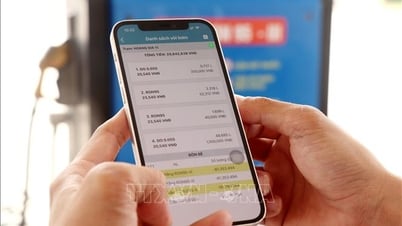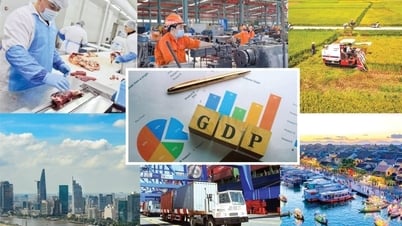Development potential and barriers to be removed
The private economic sector, focusing on small and medium enterprises (SMEs), accounts for about 98% of the total number of enterprises operating in the economy, playing a very important role in socio-economic development. In the period 2020 - 2023, the private economy contributed an average of 50.3% of GDP, higher than the state economic sector with 20.8% and the FDI sector with 20.2%.
In particular, the private economic sector has formed a number of large enterprises and corporations in a number of important industries and sectors of the economy...; contributing about 1 billion USD to social security annually.
According to Dr. Can Van Luc - Chief Economist of BIDV, the ability of SMEs to access capital is often proportional to the level of socio-economic development. In developed countries, diverse financial markets help SMEs easily mobilize capital through credit, bonds or investment funds. On the contrary, in underdeveloped countries, limitations in financial infrastructure make access to capital a difficult problem.
IFC statistics show that, in the world, SMEs can access about 40 different sources of capital. Meanwhile, in Vietnam, there are only about 6 main sources of capital for SMEs and they mainly rely on bank credit channels, a small part through guarantees and financial leasing, along with equity and partner capital such as deferred payment, letters of credit, while alternative sources of capital such as investment funds or the bond market are still very limited.
 |
Currently, Vietnam has a legal framework for SMEs such as: Law on Support for SMEs 2017; Law on Credit Institutions (amended) 2024; support policies for the period 2015-2024 and credit priority policies of the State Bank. However, SMEs still face difficulties in accessing capital. According to Dr. Can Van Luc, this problem comes from both businesses and financial institutions.
For SMEs, the barrier to lending to this sector is that it is more risky than other sectors because the credit history of the enterprise does not meet the requirements of credit institutions. In addition, enterprises have difficulty proving capital contribution in assets as well as not having enough collateral. Financial statements of enterprises often do not meet the requirements of credit institutions. Enterprises also have not established business plans and debt repayment plans as required by credit institutions.
From the side of credit institutions, barriers often come from the fact that credit institutions are reluctant to lend due to incomplete and unclear information about businesses. In addition, high risks lead to increased interest rates, which exceed the capacity of businesses. Lending based on cash flow is also difficult because business information is not public, transparent and accurate. Barriers also come from the recent criminalization of economic relations.
Regarding capital from non-bank credit institutions, Vietnam currently has 1,176 QTDNDs, 10 financial leasing companies, 16 consumer finance companies and 4 microfinance institutions. However, the proportion of capital mobilized from these units accounts for only 1% of the total outstanding debt of the entire system, very small compared to actual demand. Compared to neighboring countries such as Laos reaching nearly 7%, Cambodia reaching more than 23%, it can be clearly seen that Vietnam's proportion is very low.
Dr. Can Van Luc said that we should strive to increase this rate to 2% in the coming time and aim for 3% by 2030, instead of relying too much on the banking system.
Regarding capital access channels through the stock market, corporate bonds or investment funds, in reality in Vietnam most SMEs are not listed because they do not meet the listing requirements and sometimes because businesses do not want to publicize and be transparent about their information.
In addition, businesses have little experience and understanding of this channel, and the cost of raising capital through this channel is often high compared to businesses. Businesses are also not interested in approaching investment funds because these funds often want to participate in management or own a large number of shares in the business.
Or the capital access channel through the SME Development Fund. Although promoted since 2018, by mid-2024, the SME Development Fund had only disbursed about 600 billion VND, showing that its effectiveness was still very limited. The reason comes from the mindset of preserving 100% capital, making the staff at the Fund not dare to make decisions due to fear of risks. According to Dr. Can Van Luc, in reality, out of 100 loans, 1-2 loans may be lost, but the remaining 98 loans are still completed, enough to compensate and create profits.
In addition, the lack of communication between banks and funds is also a problem. For example, for the same loan, the bank accepts collateral but the fund does not or vice versa. There are cases where both parties demand collateral, putting the business in a difficult position.
“In Thailand, it is enough for one of the two parties to accept the collateral, thanks to the interconnected and mutually recognized system. This is a lesson that Vietnam needs to apply,” said Dr. Can Van Luc.
Access to capital through online/peer-to-peer lending is also underdeveloped because this channel is mainly for individual loans. In Vietnam, this is not yet an official channel because there is no testing mechanism for Fintech. Besides, this channel is also quite risky due to lack of legal basis and lack of transparency in information.
What solutions improve access to capital for SMEs?
To solve the problem of capital access, Dr. Can Van Luc proposed a series of synchronous solutions, from management agencies to SMEs themselves.
It is necessary to complete the legal corridor including building a sandbox mechanism for fintech in the fields of banking, insurance and securities.
Developing the capital market, especially stocks, bonds and investment funds, is also an important direction, instead of relying on establishing a separate trading floor for SMEs.
In addition, we need to innovate and improve the efficiency of the SME Development Fund and strengthen the credit guarantee system. “With 28 ineffective local funds, we need to consider whether to establish a national fund or not. And if we keep the local fund, we need to have measures to improve efficiency and change the mindset of capital preservation,” Dr. Can Van Luc suggested.
In addition, it is necessary to develop non-bank credit institutions. Although the Law on Credit Institutions (amended) has removed some barriers for the group of financial companies and people's credit funds, the effectiveness of this group is still slow and modest.
Upgrading the credit information system and financial infrastructure is a core element. To increase access to credit for borrowers, the credit information system needs to be strengthened and improved, with wider coverage, accuracy and objectivity.
At the same time, digital transformation and financial education are promoted to open up opportunities for online capital mobilization channels. The Law on Credit Institutions (amended) 2024 has two major advances when it officially allows online lending and lending under 100 million VND without a business plan.
On the part of SMEs, it is necessary to improve competitiveness and meet the standards for participating in supply chains and value chains. At the same time, SMEs must increase openness, transparency and professionalism in finance, accounting and management. Along with that, diversify capital sources. Not only relying on bank credit, SMEs must increase access to capital through channels such as guarantee funds, development funds and financial leasing.
In addition, SMEs promote digital and green transformation, towards listing and issuing securities.
For financial institutions, research and design more suitable products and services. In addition, efforts should be made to lend based on cash flow with transparent information from businesses. Flexibility of collateral such as inventory, invoices, and delivery orders.
Financial institutions continue to simplify administrative procedures, promote digital transformation and financial education to improve the understanding of businesses and people, and limit the use of black credit.
Source: https://thoibaonganhang.vn/can-dong-bo-cac-giai-phap-de-doanh-nghiep-nho-va-vua-phat-trien-ben-vung-162079.html






![[Photo] General Secretary To Lam begins official visit to Russia and attends the 80th Anniversary of Victory over Fascism](https://vphoto.vietnam.vn/thumb/1200x675/vietnam/resource/IMAGE/2025/5/8/5d2566d7f67d4a1e9b88bc677831ec9d)
![[Photo] Prime Minister Pham Minh Chinh meets with the Policy Advisory Council on Private Economic Development](https://vphoto.vietnam.vn/thumb/1200x675/vietnam/resource/IMAGE/2025/5/8/387da60b85cc489ab2aed8442fc3b14a)
![[Photo] National Assembly Chairman Tran Thanh Man chairs the meeting of the Subcommittee on Documents of the First National Assembly Party Congress](https://vphoto.vietnam.vn/thumb/1200x675/vietnam/resource/IMAGE/2025/5/8/72b19a73d94a4affab411fd8c87f4f8d)
![[Photo] President Luong Cuong presents the decision to appoint Deputy Head of the Office of the President](https://vphoto.vietnam.vn/thumb/1200x675/vietnam/resource/IMAGE/2025/5/8/501f8ee192f3476ab9f7579c57b423ad)




















































































Comment (0)